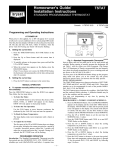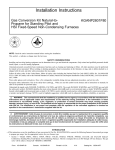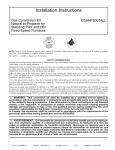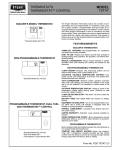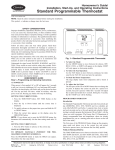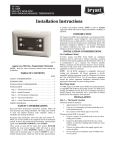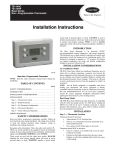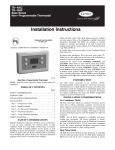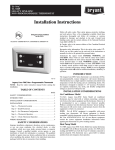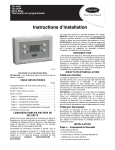Download Bryant 349MAV Instruction manual
Transcript
installation and start-up instructions TSTAT BUILDER’S NON-PROGRAMMABLE THERMOSTAT Cancels: II TSTAT-0-25 II TSTAT-0-26 8-99 NOTE: Read the entire instruction manual before starting the installation. SAFETY CONSIDERATIONS Read and follow manufacturer instructions carefully. Follow all local electrical codes during installation. All wiring must conform to local and national electrical codes. Improper wiring or installation may damage thermostat. Recognize safety information. This is the safety-alert symbol . When you see this symbol on the equipment and in the instruction manual, be alert to the potential for personal injury. Understand the signal words DANGER, WARNING, and CAUTION. These words are used with the safety-alert symbol. DANGER identifies the most serious hazards which will result in severe personal injury or death. WARNING signifies a hazard which could result in personal injury or death. CAUTION is used to identify unsafe practices which would result in minor personal injury or product and property damage. INTRODUCTION The Builder’s Model thermostat is an electronic 24-vac, nonprogrammable, manual changeover wall mount thermostat. This thermostat uses a single set point to maintain and control room temperature in both the heating and air conditioning modes. The thermostat is designed to maintain +/- 2°F accuracy. No batteries are required; temperature, fan, mode, and installer configuration settings are preserved with power off. INSTALLATION CONSIDERATIONS A. Air Conditioner Model TSTATBBBAC01-B, the Builder’s Model air conditioner thermostat, may be wired with or without connecting a common wire between the indoor equipment and the thermostat. However, it is recommended to use a common wire whenever possible. Without a common wire this thermostat becomes "power stealing." This means it will need to steal a small amount of power from the equipment to which it is connected. When "power stealing" method is used, the supplied 270 ohm load resistor must be connected at the indoor unit. (See Fig. 2, 3, 5, and notes.) NOTE: Not all HVAC equipment is compatible with power stealing type thermostats. For all non-Bryant equipment, consult the system equipment Installation Instructions before applying this thermostat in a power stealing manner. —1— A98191 Fig. 1—Builder’s Non-Programmable Thermostat CAUTION: The following Bryant equipment is not compatible with the AC version (TSTATBBBAC01-B) of this thermostat. 355MAV Variable Speed Furnace 394HAD, 396HAD 373LAD, 383KAD Standing Pilot Furnace 361A, 362A, 363A 367A, 369A Oil Furnaces 349MAV Gas Furnace TSTATXXCNV10 Thermostat Conversion Kit B. Heat Pump Model TSTATBBBHP01-B, the Builder’s Model heat pump thermostat, is compatible with all Bryant heat pump systems. It is NOT power stealing and MUST have both the R and C terminals connected to operate properly. This thermostat uses a green LED to indicate auxiliary heat and emergency heat operation. I. THERMOSTAT LOCATION Thermostat should be mounted: • Approximately 5 ft (1.5m) from floor. • Close to or in a frequently used room, preferably on an inside partitioning wall. • On a section of wall without pipes or duct work. Thermostat should NOT be mounted: • Close to a window, on an outside wall, or next to a door leading to the outside. • Exposed to direct light and heat from a lamp, sun, fireplace, or other heat-radiating object which may cause a false reading. • Close to or in direct airflow from supply registers and return-air grilles. • II. A. In areas with poor air circulation, such as behind a door or in an alcove. To Enter the Configuration Mode: Press and hold FAN button for approximately 10 sec until room temperature disappears and the display reads "01". You are now in configuration mode. NOTE: If FAN button is pressed again, or if no button is pressed for 2 minutes, the thermostat will exit configuration mode and return to normal operation. To re-enter configuration mode, the FAN button must be pressed and held for 10 sec again. While in the configuration mode, the temperature display is used to show both the option number and the selected choice within each option. Each press of the MODE button alternates between the option number and the selection within that option. When the configuration mode is first entered, option 01 is displayed. The up and down buttons now move between the available option numbers. Once an option number is selected, press the MODE button once to display the currently selected choice within that option. After the new choice is made, press the MODE button again to return to the option number display. When finished with option selections, press the FAN button once to exit the configuration mode. INSTALL THERMOSTAT WARNING: Before installing thermostat, turn off all power to unit. There may be more than 1 disconnect. Electrical shock can cause personal injury or death. 1. Turn OFF all power to unit. 2. If an existing thermostat is being replaced: a. Remove existing thermostat from wall. b. Disconnect wires from existing thermostat, one at a time. Be careful not to allow wires to fall back into wall. c. As each wire is disconnected, record wire color and terminal marking. d. Discard or recycle old thermostat. NOTE: Mercury is a hazardous waste and MUST be disposed of properly. OPTION 01—ANTICIPATOR VALUE ADJUSTMENT This adjustment controls the sensitivity and cycle rate of the thermostat. Higher numbers increase the cycle rate in cooling. Lower numbers increase the cycle rate in heating. However, this feature will not allow more than 4 equipment cycles per hour (or 1 cycle every 15 minutes), regardless of setting. Values can range from 1 to 3. Factory default setting is 2. This default selection will provide optimum performance in nearly all installations. Try this setting first. Do not change setting unless there is evidence or need to do so. Unlike conventional anticipators, this setting is not to be determined by current draw. There is no need to measure, know, or compensate for current. AVAILABLE SELECTION: Use UP and DOWN buttons to move between values 01, 02, or 03. 3. Separate front and back (mounting base) assembly of thermostat. 4. Route thermostat wires through hole in mounting base. Level mounting base against wall (for aesthetic value only, thermostat need not be leveled for proper operation) and mark wall through 2 mounting holes. 5. Drill two 3/16-in. mounting holes in wall where marked. 6. Secure mounting base to wall with 2 anchors and screws provided making sure all wires extend through hole in plastic. 7. Strip 1/4 in. insulation from thermostat wire and adjust length to reach terminal block connector on mounting base. Match and connect proper wiring in accordance with wiring diagrams. (See Fig. 2, 3, 4, and 5.) OPTION 03—FAHRENHEIT/CELSIUS SELECTION This selection operates the thermostat in either Fahrenheit or Celsius. Factory default is F. AVAILABLE SELECTION: Use UP and DOWN buttons to change between F and C. 8. Push any excess wire back into wall. Seal hole in wall to prevent air leaks. Leaks can affect thermostat operation. Any excess wire left inside thermostat casing may also affect thermostat operation by interfering with airflow across the temperature sensor. OPTION 04—G (FAN) ON WITH W (HEAT) SELECTION This selection determines whether G (fan) output is to be ON or OFF when W (furnace or strip heat) output is ON. Most furnaces and fan coils manage their own blowers and do not require a separate G signal. For these applications, select OFF. Some auxiliary heaters require a separate G signal from the thermostat to turn on the blower. In this case, select ON. Factory default is OF (off). AVAILABLE SELECTION: Use UP and DOWN buttons to change between ON and OFF. 9. Snap thermostat together making sure terminal block connector aligns, and assembly is secure. 10. If "power stealing" method is used, be sure to attach 270 ohm load resistor at indoor unit. (See Fig. 2, 3, 5, and notes.) 11. Turn on power to unit. On power up, depending on the thermostat model being used, the LCD readout will display either, HC for air conditioner model (1-stage heat/1-stage cool), or HP for heat pump model (2-stage heat/1-stage cool). OPTION 10—O (REVERSING VALUE) ON WITH HEAT OR COOL SELECTION This selection is only available on heat pump model thermostats. This selection determines whether the reversing valve is energized in the heating or cooling mode. Factory default is C. AVAILABLE SELECTION: Use UP and DOWN buttons to change between H and C. III. SET THERMOSTAT CONFIGURATION Configuration options allow the installer to configure the thermostat for a particular installation. These selections are intended to be made at installation and normally are not modified by the homeowner. Below is a list of available options followed by a description of each one. Option 01 -- Anticipator adjustment Option 03 -- Fahrenheit or Celsius operation Option 04 -- Enable fan (G) ON with heat (W) Option 10 -- O (reversing valve) On with Heat or Cool (present on Heat Pump model only) Option 13 -- Room temperature offset adjustment Note that not all configuration option numbers are used in this product. OPTION 13—ROOM TEMPERATURE OFFSET ADJUSTMENT This option allows calibration (or deliberate miscalibration) of the room temperature sensor. There are various reasons why homeowners may want to have displayed temperature adjusted to a higher or lower value. The selected number is the number of degrees, plus or minus, which will be added to actual temperature. The numbers can range between -5 and +5. Factory default is 1. —2— AVAILABLE SELECTION: Use UP and DOWN buttons to move between -5 and +5 in steps of 1. IV. THERMOSTAT OPERATION A. Temperature Display However, if the heating demand is greater than 5°, there will be only a 3-minute delay before bringing on W. F. ″--″ (two dashes) will be displayed if the thermostat can not properly read room temperature. If ″--″ appears, replace thermostat. Thermostat will display room temperature until UP or DOWN button is pressed. The word SET appears when these buttons are pressed and the current set point is displayed. If no buttons are pressed for 5 sec, the display will change back to show room temperature. B. Error Messages E4 will be displayed if the thermostat has an internal memory failure. If E4 appears, replace thermostat. V. CHECK THERMOSTAT OPERATION A. Fan Operation Timeguard Timer A 5-minute timeguard is built into the thermostat immediately upon power up, and any time the compressor turns off. The compressor will not turn on until the timeguard has expired. The timeguard affects only compressor operation. Pressing UP and FAN buttons simultaneously will override the timeguard for 1 cycle. 1. Press FAN button. This will start continuous fan operation. FAN annunciator will turn on. 2. Press FAN button again. This will stop continuous fan operation. FAN annunciator will turn off. C. Cycle Timer In normal heating and cooling operation the thermostat will not allow more than 4 equipment cycles per hour (or 1 cycle every 15 minutes). Both the Y and W outputs have a 15-minute timer that starts counting down when the output is turned on, (e.g., if Y output is turned on for 9 minutes and then satisfies, it cannot turn back on for another 6 minutes regardless of demand). However, pressing UP and FAN buttons simultaneously or changing the set point will override the timer for 1 cycle. B. Heating Operation 1. Press MODE button until HEAT is displayed. 2. Press UP button until LCD readout reads 30° above room temperature. Press UP and FAN buttons simultaneously to defeat timers. Heating system should begin to operate immediately. 3. For HP thermostats only, press MODE button until EMHT (emergency heat) appears. Press UP and FAN buttons simultaneously to defeat timers. Emergency heating (W is ON, Y is OFF) should begin immediately. D. Minimum On Timer Once the equipment has turned on, it will remain on for a minimum of 3 minutes regardless of demand. However, the equipment can turn off in less than 3 minutes if a change in set point or a change in mode occurs. C. Cooling Operation 1. Press MODE button until COOL is displayed. E. Staging Timer If the thermostat is a heat pump model, it has 2-stage heat capability. In normal operation there is a 15-minute delay between the first and second stages of heat. The Y output will energize first, then 15 minutes later, W is allowed to come on if the thermostat determines it is not satisfying the demand. 2. Press DOWN button until LCD readout reads 30° below room temperature. Press UP and FAN buttons simultaneously to defeat timers. Cooling system should begin to operate immediately. BUILDER’S MODEL THERMOSTAT CONFIGURATION RECORD Owner/Operator __________________________________________ Date ________________________________________________ Indoor Unit Model No. ______________________________________ Outdoor Unit Model No. _________________________________ A) Mode Settings _____ Mode (OFF, HEAT, COOL, EMHT) _____ Heat/Cool Set Point Value _____ Fan (AUTO or ON) B) Configuration Options 1 3 4 10 13 _____ Anticipator (1-3: factory default = 2) _____ Fahrenheit or Celsius (F or C: factory default = F) _____ Fan On with W (Off or On: factory default = Off) _____ O (reversing valve) On with heat (H), or Cool (C) (factory default = C) _____ Room Temperature Offset (-5 to +5: factory default = 0) (Note: Configuration Options 2, 5, 6, 7, 8, 9, 11, 12 are not applicable) A99277 —3— AC THERMOSTAT HEATING W W FAN G G 24 VAC HOT R R 24 VAC COMM C COOLING Y N/A O * 270 Ω, 10 W * RESISTOR (SUPPLIED) C C Y Y TYPICAL FAN COIL/ FURNACE AC THERMOSTAT TYPICAL FAN COIL/ SINGLE-SPEED FURNACE AIR CONDITIONER HEATING W W FAN G G 24 VAC HOT R R 24 VAC COMM C COOLING Y N/A O * 270 Ω, 10 W * RESISTOR (SUPPLIED) C Y * See note 1 A99115 * See note 1 A99154 Fig. 3—Typical Heat Only Fig. 2—Typical Air Conditioner HEAT PUMP THERMOSTAT TWO-ZONE THERMOSTAT INPUT AC THERMOSTAT TYPICAL SINGLE-SPEED HEAT PUMP FAN COIL HEAT STAGE 2 W W W HEATING W W1 REVERSING VALVE O O O FAN G G FAN G G 24 VAC HOT R R 24 VAC HOT R R R 24 VAC COMM C 24 VAC COMM C C C COOLING Y HEAT/COOL STAGE 1 Y Y Y N/A O * C Y1 270 Ω, 10 W * RESISTOR (SUPPLIED) * See note 2 A98217 A99116 Fig. 5—Two-Zone with Air Conditioner Fig. 4—Typical Heat Pump *WIRING DIAGRAM NOTES 1. If "power stealing" method is used, leave C terminal disconnected between thermostat and equipment and add the supplied 270 ohm load resistor as shown. 2. Power stealing method may not be used with the Two-Zone system. In addition, the supplied 270 ohm load resistor MUST always be connected between Y1 and C at Two-Zone input as shown. © 1999 Bryant Heating & Cooling Systems 7310 W. Morris St. Indianapolis, IN 46231 —4— Printed in U.S.A. iitst026 Catalog No. 13TS-TA16




